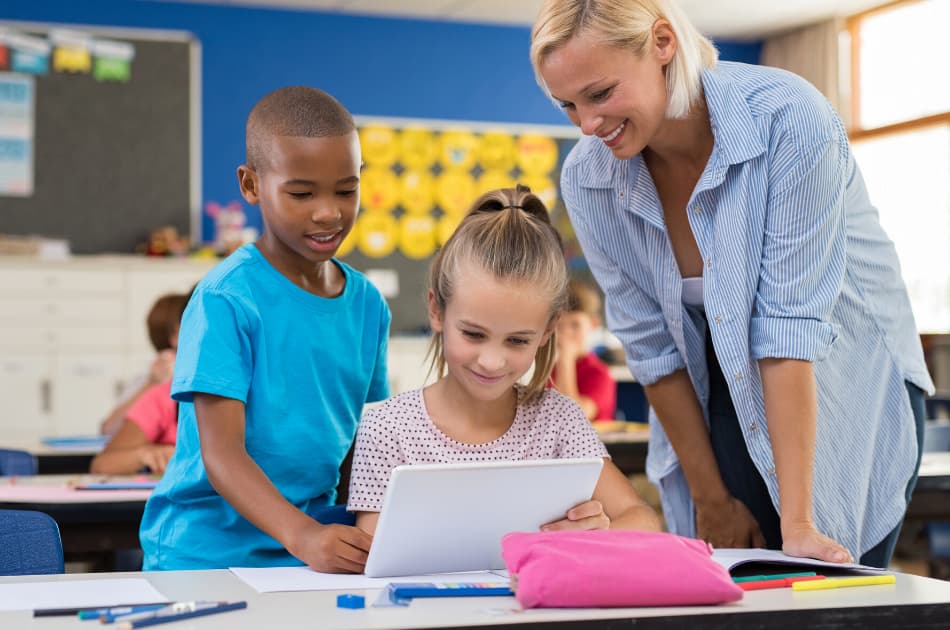Today’s teachers are equipped with more technological tools than ever before. According to Digital Education, 94 percent of schools report that digital learning is happening in at least half of their classrooms. Integrating technology into the classroom not only makes learning more relatable but also provides an opportunity for deeper, more personalized learning for each student.
Technology is a multi-faceted advantage for classrooms that can impact students and educators in a variety of ways. Read on to explore real-world examples of technology’s positive impact on learning.
Download Our Free Guide to Earning Your EdD
Learn how an EdD can give you the skills to enact organizational change in any industry.
How Technology Can Impact Student’s Learning
Even the best teachers deal with resistance from students either because the student cannot relate to the teacher or they cannot relate to the subject material. The best thing an educator can do for a student is to empower them to be responsible for their learning. Technology helps them do this with very little upfront training.
GoGuardian, a device management solution company for classrooms says, “With technology in hand, students suddenly become the builders of their own knowledge, and they experience a greater sense of independence and autonomy from using digital tools to augment their understanding.”
Along with making learning more personalized to each student, technology is also helping teachers, students, and their families connect increasingly outside the classroom. Students can reach out for extra help or resources when they need it, and families can work together with their child and their child’s teacher for optimal learning.
Benefits of Integrating Technology into the Classroom
There are many ways to enhance a classroom with technology. Here are two examples of why using tech in the classroom gives students the extra learning edge.
Students Can Set Their Own Pace
Joan Giblin, PhD, an assistant teaching professor in the Graduate School of Education at Northeastern University, explains that the use of technology has become common in the K-12 setting. “Students can work ahead or review content according to their needs,” she says. “This allows students to proceed at their own pace and receive specific reinforcement on some content and access more challenging content as needed.”
Connecting Students to the World with Social Media and Virtual Reality
Imagine being a teacher based in Boston and teaching your class about Switzerland. Your lesson might fall a little flat with just a book’s description and photos of the country. Utilizing technology, your class can conduct a virtual chat and interview with a class in Switzerland. They might be able to write and send emails to a government official who is happy to answer questions about the country or even use virtual reality tech to take tours of landmarks and local museums.
Ways Teachers Integrate Technology to Improve Outcomes
Gamification Makes Learning More Rewarding
Most students naturally love games, whether video games or board games. Children especially are wired for fun, which can make sitting still in a classroom for several hours a day difficult. Not all gaming is bad, and Psychological Bulletin reported that 10 to 30 hours of select gameplay per week can improve a student’s spatial cognition and multitasking ability. Teachers are using gamification strategies to drum up interest in a specific subject or to help young minds dive deeper into a topic without relying solely on books and lectures. For example, instead of another worksheet on vocabulary words, an app or game that features silly cartoon monsters can be used to help kindergartners have fun while learning basic phonics.
Gamification doesn’t always require technology. A trivia game created from your history lesson on a dry erase board would be a form of gamifying, too. However, children are entering classrooms addicted to technology, so using the technology they are familiar with to teach them new subjects is a practical way to connect with the modern student.
Gamification can help with student’s social and behavioral development as well. “I am particularly intrigued by the growing trend of creating games to assist students with developing socio-emotional regulation,” Giblin says. “This has the ability to help students with difficulties in these areas gain mastery, allowing them to better engage with their academics.”
Technology Allows Students to Do More
A few decades ago, students were limited in project creation. For example, if a class wanted to collaborate to write a book, getting it published in a timely and affordable manner was not a possibility. Similarly, recording any audio or video required expensive and specialized equipment. Now, many students have easier access to technology, making goals like these possible.
“Technology allows students to author and create their projects, moving them into higher-order learning,” Giblin says. “Instead of reading about a topic, students can create and author learning experiences for themselves and others. For example, a middle school class discussing empathy may interview different people about their understanding of what it means to be empathetic.”
Giblin explains that through the use of technology, the students are able to detect patterns and non-verbal responses when they analyze the interviews. They are then able to create their own content based on what they learned to teach their classmates.
How Teachers Can Utilize Technology to Have a Greater Impact
As an educator, you have access to millions of teachers worldwide at your fingertips. Use technology to connect with them and share ideas. Ideas and resources from others with different teaching styles, grade levels, and viewpoints are easily accessible. For example, you might learn a new strategy for teaching cultural awareness from a teacher overseas, or your unique idea on how to conduct collaborative screenwriting with a tablet might inspire a teacher across the country.
Technology is never meant to replace a trained and caring teacher, though. Instead, technology-driven education can benefit both the educator and the student by allowing them to make the classroom experience unforgettable.
Find out how you can learn more tech-centered ideas for the classroom through Northeastern’s Doctor of Education program. Students can complete their studies in their own time, virtually. You will be learning real-world applications that you can start integrating into your classroom immediately.
To learn more about what a Doctor of Education program can do for you, download our free guide below.







Related Articles
What is Learning Analytics & How Can it Be Used?
Reasons To Enroll in a Doctor of Education Program
Why I Chose to Pursue Learning Analytics